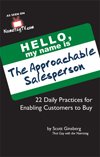
 During my time at Miami University, I was a Marketing Major.
During my time at Miami University, I was a Marketing Major.
The first piece of advice I remember from my professor, Mrs. Young was:
“In Marketing, the answer to every question is always ‘Well, that depends…’”
The class got a good chuckle out that one.
Amazingly, more than ten years later, that idea still holds true. Not just in marketing, but in ANY question/answer situation:
Between you and your employees.
Between you and your customers.
Between you and the media.
Between you and your significant other.
Between you and your children.
Between you and your dogs.
OK, maybe not your dogs.
STILL: Answering creatively or counterintuitively leads to a higher level of thinking.
Which elevates the conversation to a new level.
Which enables both parties to discover their individual truths.
Which yields more compelling results than if you would have offered a simple yes or no.
Let’s explore a list of ten ways to answer questions in a more intelligent, more approachable way. We’ll do 1-5 in part one today and 6-10 in part two next week.
1. “Well, there are a couple of answers to that question.” Don’t kill yourself trying to come up with ONE answer. Unless the question is about calculus, set your mind free! Resigning yourself to only providing one answer is a creative block.
Conversely, every time you offer multiple answers, you’re strengthening your foundation of creative, expansive thinking. And in the eyes of the questioner, you appear smarter, more open minded and more thorough.
What’s more, single answers have the potential to alienate people. Especially in a group setting. So, by offering multiple responses, you increase the probability of appealing to the largest number of people. More answers = More people on your side.
2. “Well, that depends on how you define the word ‘x.’” As a writer and wordsmith, this is my personal favorite. First, it PROVES that you were (actually) listening. It also shows that you think differently, and that you choose your words carefully.
For example, when someone asks me, “How often do you meditate?” my response is, “Well, that depends on your definition of meditation. If you define the word meditation as ‘formal sitting and quieting of the mind,’ then my answer is ‘twice a day;’ but if you define the word meditation as ‘mindfulness breathing and present moment awareness,’ then my answer is ‘All day.’”
It’s a probability statement, which demonstrates that you honor multiple perspectives. That you practice cognitive flexibility. What’s more approachable than that?
3. Word distinction. Similar to defining (or redefining) a word, you can also make the distinction between two commonly confused or misused words. For example:
QUESTION: “Were you scared?”
ANSWER: “Well, being scared isn’t the same as being afraid.”
QUESTION: “Did you lose the game?”
ANSWER: “We didn’t just lose, we got defeated!”
QUESTION: “Is your business growing?”
ANSWER: “Well, I’m more concerned if my business is flourishing.”
By offering these kinds of distinctions, you maintain control of the conversation AND inspire the other person to think twice about the subtle difference between similar terms.
4. Pause. Don’t say anything. Just think. Listen to your own quiet voice. Take your time. Ponder your response. Let the silence speak to you and then choose your words carefully.
Learn to accept silence as a normal part of conversations. Your contemplation will show respect to the questioner. What’s more, any form of pausing – whether it’s in writing, speaking or singing – automatically increases the … VOLUME … of that which comes before and after it.
5. “Well, let’s take that in pieces…” My friend Richard, a veteran in the mental health profession, often uses this type of answer. Breaking your answer into pieces accomplishes several conversational goals.
First, it demonstrates effective listening.
Second, it exemplifies patience, especially when a client emotionally unloads on you.
Third, it enables the answerer to digest the entirety of the question, thus providing a response that addresses all of the important issues.
– – –
That’s how to answer a question. Here’s part two.
Ans I’m sure there are more possibilities, so…
LET ME ASK YA THIS…
How do YOU answer questions?
LET ME SUGGEST THIS…
For the list called, “62 Types of Questions and Why They Work,” send an email to me, and I’ll send you the list for free!
* * * *
Scott Ginsberg
That Guy with the Nametag
scott@hellomynameisscott.com
 Sick of selling?
Sick of selling?
Tired of cold calling?
Bored with traditional prospecting approaches?
Buy Scott’s new book and learn how to sell enable people to buy!
Pick up your copy (or a case!) right here.
